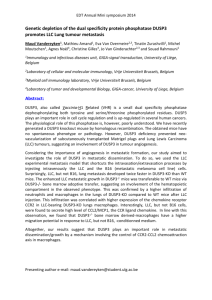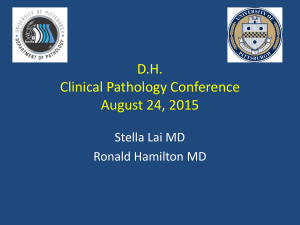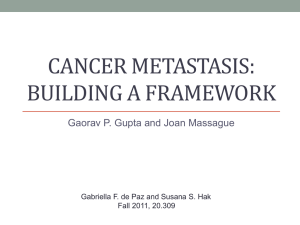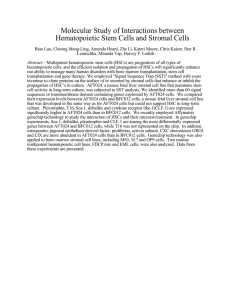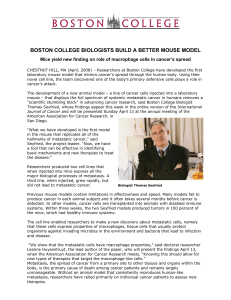VEGF-A and Tenascin-C produced by S100A4[superscript
advertisement
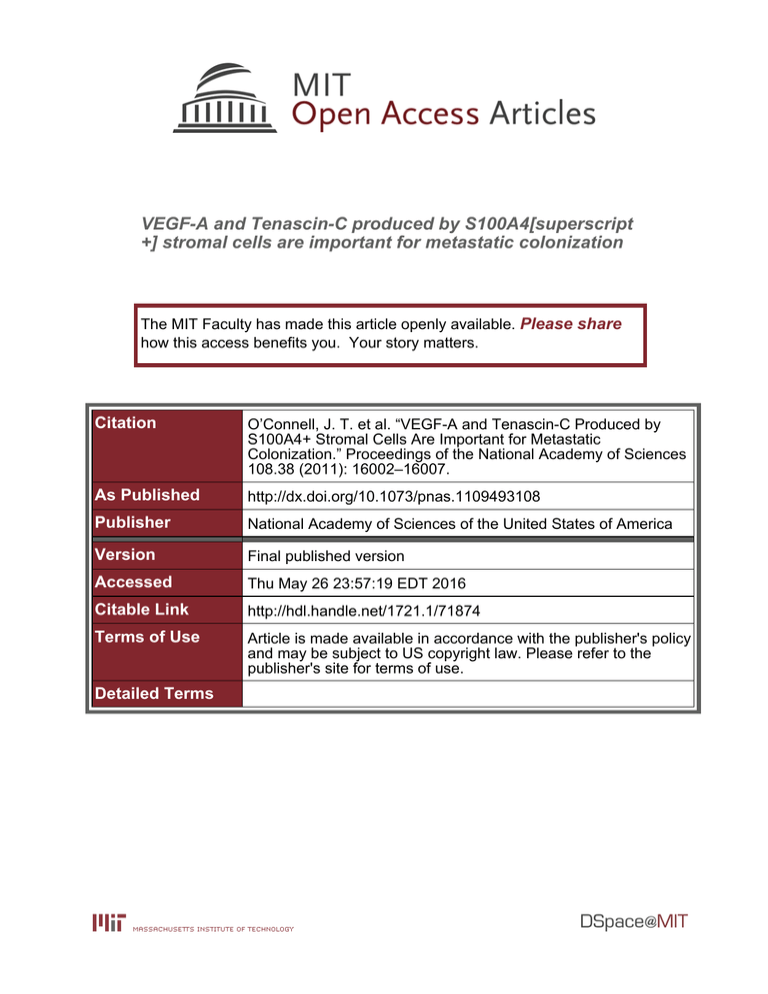
VEGF-A and Tenascin-C produced by S100A4[superscript +] stromal cells are important for metastatic colonization The MIT Faculty has made this article openly available. Please share how this access benefits you. Your story matters. Citation O’Connell, J. T. et al. “VEGF-A and Tenascin-C Produced by S100A4+ Stromal Cells Are Important for Metastatic Colonization.” Proceedings of the National Academy of Sciences 108.38 (2011): 16002–16007. As Published http://dx.doi.org/10.1073/pnas.1109493108 Publisher National Academy of Sciences of the United States of America Version Final published version Accessed Thu May 26 23:57:19 EDT 2016 Citable Link http://hdl.handle.net/1721.1/71874 Terms of Use Article is made available in accordance with the publisher's policy and may be subject to US copyright law. Please refer to the publisher's site for terms of use. Detailed Terms VEGF-A and Tenascin-C produced by S100A4+ stromal cells are important for metastatic colonization Joyce T. O’Connella,1, Hikaru Sugimotoa,1, Vesselina G. Cookea, Brian A. MacDonalda, Ankit I. Mehtaa, Valerie S. LeBleua, Rajan Dewara,b, Rafael M. Rochac, Ricardo R. Brentanic, Murray B. Resnickd, Eric G. Neilsone, Michael Zeisberga, and Raghu Kalluria,f,g,2 a Division of Matrix Biology, Department of Medicine, and bDepartment of Pathology, Beth Israel Deaconess Medical Center and Harvard Medical School, Boston, MA 02115; fDepartment of Biological Chemistry and Molecular Pharmacology, Harvard Medical School, Boston, MA 02115; cDepartment of Oncology, Hospital A. C. Camargo, Fundacao Antonio Prudente, 01509-010, Sao Paulo, Brazil; dDepartment of Pathology, Rhode Island Hospital, Providence, RI 02903; e Departments of Medicine and Cell and Developmental Biology, Vanderbilt University, Nashville, TN 37215; and gDivision of Health Sciences and Technology, Harvard-Massachusetts Institute of Technology, Boston, MA 02215 Edited by Napoleone Ferrara, Genentech, Inc., South San Francisco, CA, and approved August 8, 2011 (received for review June 14, 2011) Increased numbers of S100A4+ cells are associated with poor prognosis in patients who have cancer. Although the metastatic capabilities of S100A4+ cancer cells have been examined, the functional role of S100A4+ stromal cells in metastasis is largely unknown. To study the contribution of S100A4+ stromal cells in metastasis, we used transgenic mice that express viral thymidine kinase under control of the S100A4 promoter to specifically ablate S100A4+ stromal cells. Depletion of S100A4+ stromal cells significantly reduced metastatic colonization without affecting primary tumor growth. Multiple bone marrow transplantation studies demonstrated that these effects of S100A4+ stromal cells are attributable to local non–bone marrow-derived S100A4+ cells, which are likely fibroblasts in this setting. Reduction in metastasis due to the loss of S100A4+ fibroblasts correlated with a concomitant decrease in the expression of several ECM molecules and growth factors, particularly Tenascin-C and VEGF-A. The functional importance of stromal Tenascin-C and S100A4+ fibroblast-derived VEGF-A in metastasis was established by examining Tenascin-C null mice and transgenic mice expressing Cre recombinase under control of the S100A4 promoter crossed with mice carrying VEGF-A alleles flanked by loxP sites, which exhibited a significant decrease in metastatic colonization without effects on primary tumor growth. In particular, S100A4+ fibroblast-derived VEGF-A plays an important role in the establishment of an angiogenic microenvironment at the metastatic site to facilitate colonization, whereas stromal Tenascin-C may provide protection from apoptosis. Our study demonstrates a crucial role for local S100A4+ fibroblasts in providing the permissive “soil” for metastatic colonization, a challenging step in the metastatic cascade. | | stromal fibroblasts metastasis-associated fibroblasts tumor microenvironment metastatic microenvironment | A bout 90% of cancer deaths are attributable to systemic disease associated with metastasis (1). Among the steps involved in metastasis, the colonization step is considered the most challenging for an invading cancer cell (2). With metastatic disease as the leading cause of death among patients who have cancer (3), a greater need is emphasized for a better understanding of the metastatic process so as to identify efficacious cancer therapies. S100A4 (also known as CAPL, p9Ka, 42A, pEL98, mts1, metastasin, calvasculin, 18A2, or FSP1) is a member of the S100 calcium-binding family, which has a high prognostic significance for metastasis in patients with cancer (4). Several studies have demonstrated a correlation between increased numbers of S100A4+ cells and poor prognosis of patients for a variety of cancer types, including colorectal adenocarcinoma, non-small cell lung cancer, breast adenocarcinoma, gastric cancer, esophageal squamous carcinoma, bladder cancer, prostate adenocarcinoma, melanoma, and ovarian carcinoma. Although S100A4+ cells encompass a variety of cell types, including malignant cancer cells and host stromal cells (5), studies have primarily focused on the metastatic properties of S100A4+ cancer cells (6–9). 16002e16007 | PNAS | September 20, 2011 | vol. 108 | no. 38 It has long been speculated that the metastatic microenvironment may be an important determinant in the establishment of metastases (10), but support for the importance of stromal interactions in metastasis is still largely lacking. Others have demonstrated that the metastatic microenvironment contains greater numbers of S100A4+ stromal cells than the primary tumor microenvironment (11). In light of this, the present study investigated the functional contribution of S100A4+ stromal cells in metastasis. Results S100A4+ Stromal Cells in the Tumor and Metastatic Microenvironments. 4T1 breast cancer cells, when injected into the mammary fat pad of syngeneic female BALB/c mice, readily metastasize to the lung. Using this orthotopic cancer model allows us to distinguish between S100A4+ cancer cells and S100A4+ stromal cells, and also to study stromal interactions within a relevant microenvironment. To determine whether an influx of S100A4+ stromal cells correlates with metastasis, we used S100A4-GFP transgenic mice (6) in which the S100A4 promoter drives expression of GFP, allowing us to track any S100A4+ stromal cells. In normal breast tissue and normal lung tissue, we observed few S100A4+ stromal cells. In the setting of cancer, S100A4+ stromal cells increased slightly in number within the tumor microenvironment (Fig. 1A), while there was a significant increase in S100A4+ stromal cells associated with metastasis (Fig. 1B). This accumulation of S100A4+ stromal cells in the tumor and metastatic microenvironments corresponds with observations previously seen in human cancers. We further confirmed that S100A4+ cells accumulate in the stromal regions surrounding metastatic nodules of patients with cancer (Fig. S1). Ablation of S100A4+ Stromal Cells Attenuates Metastasis. To func- tionally assess the role of S100A4+ stromal cells in metastasis, we used transgenic mice expressing viral thymidine kinase under control of the S100A4 promoter (S100A4-tk mice), in which ganciclovir (GCV) treatment results in the selective ablation of S100A4+ stromal cells (12). In the physiological setting, few S100A4+ stromal cells reside in the normal lung; however, many S100A4+ stromal cells proliferate in response to invading cancer cells in the metastatic lung (Fig. S2A). The S100A4-tk model can Author contributions: J.T.O., H.S., and R.K. designed research; J.T.O., H.S., V.G.C., B.A.M., A.I.M., V.S.L., and R.M.R. performed research; E.G.N. contributed new reagents/analytic tools; J.T.O., H.S., V.S.L., R.D., R.M.R., R.R.B., M.B.R., M.Z., and R.K. analyzed data; J.T.O. and R.K. wrote the paper; and R.R.B. and M.B.R. provided human specimens. The authors declare no conflict of interest. This article is a PNAS Direct Submission. Data deposition: Microarray data have been deposited in National Center for Biotechnology Information’s Gene Expression Omnibus (GEO) and are accessible through GEO Series accession no. GSE31711. 1 J.T.O. and H.S. contributed equally to this work. 2 To whom correspondence should be addressed. E-mail: rkalluri@bidmc.harvard.edu. This article contains supporting information online at www.pnas.org/lookup/suppl/doi:10. 1073/pnas.1109493108/-/DCSupplemental. www.pnas.org/cgi/doi/10.1073/pnas.1109493108 % BrdU+ metastatic cancer cells H 15 % TUNEL+ metastatic cancer cells D *** 20 10 0 CD31 Normal 5 Met CD31 5 0 100 90 Control Tumor S100A4-tk GCV Tumor CD31 CD31 * 80 70 60 Control S100A4-tk GCV Control Metastatic Lung S100A4-tk GCV Metastatic Lung 2000 1000 0 Control S100A4-tk GCV 4 3 2 1 0 ** Control S100A4-tk GCV 20 25 Control Metastatic Lung Normal Tumor 10 Control S100A4-tk GCV G 0 3000 S100A4-tk GCV Metastatic Lung Metastatic Lung 30 5 E # CD31+ microvessels per x400 visual field S100A4-GFP 10 4000 # CD31+ microvessels per x400 visual field S100A4-GFP C Tumor volume (mm3) Mammary Tumor 15 % Metastatic area Normal Mammary Normal Lung F S100A4-GFP # S100A4-GFP+ cells per x400 visual field B S100A4-GFP # S100A4-GFP+ cells per x400 visual field A 15 10 5 0 Control S100A4-tk GCV 20 15 ** 10 5 0 Control S100A4-tk GCV take advantage of the activation of S100A4+ stromal cells in response to metastasis and target these proliferating cells for selective ablation. 4T1 cancer cells were orthotopically implanted into GCV-treated S100A4-tk mice and control littermates. S100A4-tk+ stromal cells were significantly depleted in the mammary tumor and metastatic lung of GCV-treated S100A4-tk mice (Fig. S2B). Ablation of S100A4+ stromal cells had no effects on primary tumor growth (Fig. 1C); however, metastatic colonization was significantly attenuated (Fig. 1 D and E). Administration of GCV had no effect on tumor growth or metastasis in WT mice (Fig. S3), confirming that decreased metastatic colonization in GCV-treated S100A4-tk mice was not attributable to nonspecific GCV toxicity. The percentage of proliferating cancer cells within metastatic nodules was not significantly affected by the ablation of S100A4+ stromal cells (Fig. 1F); however, analysis of apoptosis demonstrated a significant increase in the percentage of apoptotic cancer cells within the metastatic nodules of GCV-treated S100A4-tk mice (Fig. 1G). Increased apoptosis in GCV-treated S100A4-tk mice was further associated with decreased angiogenesis at the metastatic site, whereas angiogenesis at the primary tumor site was not significantly affected (Fig. 1H). These results implicate a specific role for S100A4+ stromal cells in metastatic colonization. static microenvironment than in the primary tumor microenvironment. In addition, the ablation of S100A4+ stromal cells only inhibited angiogenesis at the metastatic site and not at the primary tumor site. Therefore, we speculated that S100A4+ stromal cells may act directly at the metastatic site to facilitate metastatic colonization. To bypass any primary tumor contribution, we injected 4T1 cancer cells i.v. into GCV-treated S100A4-tk mice and control littermates. Even in the absence of a primary tumor, metastatic colonization was still significantly impaired after ablation of S100A4+ stromal cells (Fig. 2A). Although the percentage of proliferating cancer cells within the metastatic nodules was not significantly affected (Fig. 2B), the percentage of apoptotic cancer cells was significantly increased in the metastatic nodules of GCV-treated S100A4-tk mice (Fig. 2C). This increased apoptosis was again associated with reduced angiogenesis within the metastatic nodules of GCV-treated S100A4-tk mice (Fig. 2D). Collectively, these results support the notion that S100A4+ stromal cells act locally at the metastatic site to facilitate metastatic colonization via the establishment of an angiogenic microenvironment to support the survival and propagation of metastasizing cancer cells. S100A4+ Stromal Cells Act Locally at the Metastatic Site. Greater numbers of S100A4+ stromal cells were observed in the meta- mal cells in an alternative model of metastasis, we used the CT26 colorectal cancer cell line (Fig. S4). CT26 colorectal cancer cells, O’Connell et al. Ablation of S100A4+ Stromal Cells Also Attenuates Liver Metastasis of CT26 Colorectal Cancer Cells. To assess the role of S100A4+ stro- PNAS | September 20, 2011 | vol. 108 | no. 38 | 16003 MEDICAL SCIENCES Fig. 1. Ablation of S100A4+ stromal cells inhibits metastatic colonization of orthotopically implanted 4T1 cancer cells. S100A4+ stromal cells (green) with DAPI nuclear counterstain (blue) in normal mammary tissue vs. 4T1 mammary tumor tissue (A) and normal lung tissue vs. 4T1 metastatic lung tissue (B) from S100A4-GFP transgenic mice. (Scale bars: 50 μm.) Primary tumor volume (C) and percent metastatic area in lung tissue (D) of GCV-treated S100A4-tk mice (n = 10) and control littermates (n = 10) 24 d after orthotopic implantation of 4T1 cancer cells. (E) Representative H&E-stained lung sections with dotted lines encircling metastatic lesions. (Scale bars: 400 μm.) Quantification of BrdU+ (F) and TUNEL+ (G) cancer cells within metastatic nodules. (H) Microvessel density was quantified by CD31 staining (red) with DAPI nuclear counterstain (blue) in primary tumors and within metastatic nodules. (Scale bars: 20 μm.) Mean ± SEM. *P < 0.05; **P < 0.01; ***P < 0.001. Control S100A4-tk GCV % BrdU+ metastatic cancer cells S100A4-tk GCV 30 50 S100A4-tk GCV S100A4+ Immune Cells Do Not Have a Significant Impact on Metastasis. 20 10 0 Control S100A4-tk GCV ** 25 0 Control S100A4-tk GCV To functionally distinguish between S100A4+ immune cells and S100A4+ fibroblasts in metastasis, we performed various bone marrow transplant experiments with the S100A4-tk transgenic mice. Because S100A4+ immune cells primarily derive from the bone marrow, S100A4+ immune cells can be targeted for selective ablation via the GCV treatment of WT mice transplanted with S100A4-tk bone marrow. Alternatively, ablation can be limited to mostly S100A4+ fibroblasts in GCV-treated S100A4-tk transgenic mice transplanted with WT bone marrow. Consistent with our earlier findings, the ablation of all S100A4+ stromal cells in GCV-treated S100A4-tk mice transplanted with S100A4-tk bone marrow significantly reduced metastatic colonization (Fig. 3B). When the ablation of S100A4+ stromal cells was limited to A 1.2 0.8 0.4 0 ** Control S100A4-tk GCV Fig. 2. Ablation of S100A4+ stromal cells inhibits metastatic colonization of i.v. inoculated 4T1 cancer cells. (A) Percent metastatic area in lung tissue of GCV-treated S100A4-tk mice (n = 6) and control littermates (n = 6). Representative H&E-stained lung sections are displayed. Arrows point to metastatic lesions. (Scale bars: 160 μm.) Quantification of BrdU+ (B) and TUNEL+ (C) cancer cells within metastatic nodules. (D) Quantification of microvessel density by CD31 staining (red) with DAPI nuclear counterstain (blue) within metastatic nodules. Dotted lines encircle metastatic lesions. (Scale bars: 20 μm.) Mean ± SEM. **P < 0.01; ***P < 0.001. when injected into the spleen, establish metastases in the liver. In the S100A4-GFP mice, S100A4+ stromal cells are detected in negligible numbers in normal liver tissue. After implantation of CT26 cancer cells into the spleen, S100A4+ stromal cells significantly increased in number within the metastatic microenvironment of the liver. CT26 colorectal cancer cells were then injected into the spleen of GCV-treated S100A4-tk mice and control littermates. Ablation of S100A4+ stromal cells in GCVtreated S100A4-tk mice significantly impaired liver metastasis. These results demonstrate the importance of S100A4+ stromal cells in metastatic colonization of different cancer cell types at distinct organ sites. S100A4+ Immune Cells in the Metastatic Microenvironment Derive + from the Bone Marrow. S100A4 stromal cells have been identi- fied as either fibroblasts or immune cells in the breast tumor microenvironment (5). Our analysis of the metastatic microenvironment in patients with breast cancer determined that antibody staining for S100A4 exhibited a staining pattern different from that of the immune cell marker CD45 (Fig. S5); within the 16004 | www.pnas.org/cgi/doi/10.1073/pnas.1109493108 S100A4-GFP CD45/DAPI B WT BM > WT S100A4-GFP+/CD45S100A4-GFP+/CD45+ 25 20 15 10 5 0 S100A4 GFP S100A4 GFP BM TK BM > TK WT BM > WT TK BM > TK TK BM > WT WT BM > TK TK BM > WT WT BM > TK % Metastatic area 0 *** # Cells per x400 visual field Control 2.5 stromal compartment of metastatic lesions, S100A4+ cells are more prevalent than CD45+ cells. In the 4T1 breast cancer model, ∼40% of S100A4+ stromal cells expressed CD45 in the metastatic microenvironment, indicating the presence of both S100A4+ immune cells and S100A4+ fibroblasts. Bone marrow transplantation from S100A4-GFP+ transgenic donors to WT recipients demonstrated that the entire population of S100A4+ immune cells is primarily derived from the bone marrow, as the number of S100A4-GFP+/CD45+ cells remains the same between the total S100A4-GFP transgenic mice and WT mice bearing an S100A4-GFP bone marrow transplant (Fig. 3A). S100A4-GFP CD31 D 5 % TUNEL+ metastatic cancer cells Control TUNEL/CK8 C 7.5 S100A4-tk GCV Relative CD31 staining Control BrdU/CK8 B 10 S100A4-GFP BM S100A4-tk GCV % Metastatic area Control H&E A 20 * * * 15 10 5 0 Fig. 3. Bone marrow-derived S100A4+ stromal cells do not functionally contribute to metastatic colonization. (A) S100A4+ (green) and CD45+ (red) stromal cells in metastatic lung tissue of S100A4-GFP mice and WT mice bearing an S100A4-GFP bone marrow (BM) transplant. White arrows point to S100A4-GFP+ stromal cells; yellow arrowheads point to S100A4-GFP+/ CD45+ stromal cells. (Scale bars: 20 μm.) (B) Quantification of metastatic area in WT mice transplanted with WT bone marrow (WT BM > WT, n = 13), S100A4-tk mice transplanted with S100A4-tk bone marrow (TK BM > TK, n = 13), WT mice transplanted with S100A4-tk bone marrow (TK BM > WT, n = 10), and S100A4-tk mice transplanted with WT bone marrow (WT BM > TK, n = 12). Representative H&E-stained lung sections are displayed with dotted lines encircling metastatic lesions. (Scale bars: 50 μm.) Mean ± SEM. *P < 0.05. O’Connell et al. the bone marrow compartment in GCV-treated WT mice with S100A4-tk bone marrow, metastatic colonization was not significantly affected. In contrast, when only non–bone marrow-derived S100A4+ stromal cells are ablated in GCV-treated S100A4-tk mice with WT bone marrow, a significant reduction in metastatic colonization is also observed. Thus, these results suggest that bone marrow-derived S100A4+ stromal cells, which are primarily S100A4+ immune cells, do not play a significant role in metastatic colonization in this setting. S100A4+ Stromal Cells Provide Tenascin-C in Support of Metastatic Colonization. Although S100A4 protein itself can contribute to metastatic progression (13, 14), S100A4+ stromal cells may provide additional factors to foster the development of metastases. We have identified that the S100A4+ stromal cells affecting metastasis are most likely fibroblasts; thus, we surveyed the literature and used expression profiling data produced by other research groups (15–17) to generate a putative list of fibroblast-derived ECM molecules reported to be important for metastasis. We identified 12 candidate ECM molecules and assessed their expression in normal lung tissue compared with control and GCVtreated S100A4-tk lung tissue (Fig. S6A). Although Collagen I, Collagen III, Collagen XVIII, and Thrombospondin 1 showed increased expression during metastasis to implicate their potential contribution to the metastatic process, their expression did not change significantly in GCV-treated S100A4-tk mice. On the other hand, the increased expression of Fibronectin extra domain-A (ED-A) in metastasis, which concurs with the results reported by Kaplan and colleagues (18), decreased upon ablation of S100A4+ stromal cells, implicating a specific contribution of Fibronectin ED-A by S100A4+ stromal cells. However, Tenascin-C demonstrated the most differential expression: Tenascin-C was not expressed in normal lung tissue, but significant expression was observed in the metastatic nodules of control mice, which diminished to control levels upon ablation of S100A4+ stromal cells (Fig. 4A). This indicates that S100A4+ stromal cells are likely to B cells that may aid in the establishment of an angiogenic microenvironment to support metastatic colonization, we then assessed Wildtype TN-C KO 20 10 * 0 Control S100A4-tk GCV 2.0 1.5 1.0 0.5 # CD31+ microvessels per x400 visual field H&E CD31/DAPI 30 Tumor volume (mm3) TN-C/tk Relative TN-C staining C 40 2.5 0 ** WT TN-C KO 5 4 3 2 1 0 WT TN-C KO 2000 1500 1000 500 0 WT TN-C KO Fig. 4. Loss of stromal Tenascin-C inhibits metastatic colonization. (A) Representative images of the cancer cell marker luciferase (red) and Tenascin-C (green) as well as S100A4-tk (red) and Tenascin-C (green) double staining within metastatic lung tissue of control and GCV-treated S100A4-tk mice. (Scale bars: 20 μm.) The bar graph summarizes the relative Tenascin-C (TN-C) antibody staining between the two groups. (B) Percent metastatic area and microvessel density in lung tissue of TN-C KO (n = 4) and WT (Wildtype) littermates (n = 6) 4 d after i.v. inoculation of 4T1 cancer cells. Representative H&E-stained lung sections. (Scale bars: 50 μm.) CD31 staining (red) with DAPI nuclear counterstain (blue). (Scale bars: 20 μm.) Metastatic lesions are encircled by dotted lines. (C) Primary tumor volume of TN-C KO (n = 6) and WT littermates (n = 4) 24 d after orthotopic implantation of 4T1 cancer cells. Mean ± SEM. *P < 0.05; **P < 0.01. O’Connell et al. PNAS | September 20, 2011 | vol. 108 | no. 38 | 16005 MEDICAL SCIENCES S100A4-tk GCV TN-C/Luciferase Control S100A4+ Stromal Cells Provide VEGF-A in Support of Metastatic Colonization. To identify factors secreted by S100A4+ stromal % Metastatic area A be a primary source of Tenascin-C within the metastatic microenvironment. In addition, we performed gene expression profiling analysis comparing S100A4+ stromal cells isolated from normal lungs and S100A4+ stromal cells isolated from metastatic lungs, and Tenascin-C was among the top 20 ECM molecules up-regulated by metastasis-associated S100A4+ stromal cells (Fig. S6B). Thus, Tenascin-C is regulated both on the transcript level and protein level by S100A4+ stromal cells within the metastatic microenvironment, implicating its potential contribution to metastatic colonization. To specifically assess the role of Tenascin-C in metastasis, we injected 4T1 cancer cells i.v. into Tenascin-C null (TN-C KO) mice and WT littermates. Immunofluorescence labeling with antibodies specific to Tenascin-C confirmed that Tenascin-C was substantially reduced in the metastatic lesions of TN-C KO mice, demonstrating a substantial contribution of stromal cells to Tenascin-C accumulation within the metastatic microenvironment (Fig. S6C). Some speculate that Tenascin-C may be produced by endothelial cells, but double immunofluorescence for Tenascin-C and the endothelial marker CD31 in WT mice demonstrated that Tenascin-C expression did not colocalize with endothelial cells (Fig. S6D). In addition, the significant decrease in Tenascin-C expression in GCV-treated S100A4-tk mice (Fig. 4A) indicates that S100A4+ stromal cells are a primary source of Tenascin-C in the metastatic microenvironment. In the absence of stromal Tenasin-C, TN-C KO mice exhibited fewer and smaller metastatic nodules; however, no difference in angiogenesis was observed at the metastatic site (Fig. 4B). In addition, the growth of primary 4T1 tumors was not significantly altered in these mice (Fig. 4C). Together, these results suggest that stromal Tenascin-C, predominantly provided by S100A4+ cells, facilitates metastatic colonization. Discussion S100A4 was independently cloned by several research teams (19– 25) as a marker associated with cell growth and cell motility. Increased numbers of S100A4+ cells have been correlated with metastasis and poor prognosis in patients with cancer (26). The metastatic capabilities of S100A4+ cancer cells have been thoroughly studied (6–9, 11, 27); however, in the tumor microenvironment, S100A4 is also expressed by fibroblasts and immune cells, including macrophages (5). Studies using spontaneous models of cancer are unable to distinguish between the functions of S100A4+ cancer cells and S100A4+ stromal cells (6, 14). Others have assessed the function of S100A4 protein in S100A4+ stromal cells, in which the absence of S100A4 protein appears to prevent the recruitment of immune cells and fibroblasts to the tumor microenvironment (13). With S100A4’s known function in cell motility, attenuation of metastasis attributable to the loss of S100A4 protein in S100A4+ stromal cells may simply reflect restricted migration of metastasis-promoting stromal cells to the site of metastasis. 16006 | www.pnas.org/cgi/doi/10.1073/pnas.1109493108 VEGF-A/tk 30 20 10 0 ** Control S100A4-tk GCV 1500 1000 500 0 S100A4-Cre VEGF-Af/f WT WT S100A4-Cre VEGF-Af/f S100A4-Cre VEGF-Af/f % Metastatic area 4T1 orthotopic 4T1 intravenuos D 40 2500 WT C 50 2000 % Metastatic area Tumor volume (mm3) B S100A4-tk GCV % VEGF-A+/S100A4+ fibroblasts Control A 2.0 1.5 1.0 0.5 0 *** WT S100A4-Cre VEGF-Af/f 60 40 20 *** 0 WT S100A4-Cre VEGF-Af/f S100A4-Cre VEGF-Af/f 20 # CD31+ microvessels per x400 visual field WT E CD31/DAPI the chemokines and growth factors up-regulated by metastasisassociated S100A4+ stromal cells within our gene expression profile (Fig. S7A). VEGF-A was the most up-regulated gene among chemokines and growth factors by S100A4+ stromal cells during metastasis, and it is a very promising candidate for the angiogenic effects observed in GCV-treated S100A4-tk mice. We confirmed that VEGF-A had mild expression in S100A4+ cells of uninvolved stroma, with enhanced expression in S100A4+ stromal cells associated with metastasis. Furthermore, elevation of VEGFA+/S100A4+ cells within metastatic nodules was down to baseline level upon ablation of S100A4+ stromal cells (Fig. 5A). To elucidate the role of S100A4+ stromal cell-derived VEGFA in metastasis, we crossed mice expressing Cre recombinase under control of the S100A4 promoter (S100A4-Cre) with mice carrying VEGF-A alleles flanked by loxP sites (VEGF-Aflox/flox), resulting in S100A4-Cre;VEGF-Aflox/flox progeny to delete VEGFA expression specifically in S100A4+ stromal cells. The S100A4Cre mice demonstrated ∼85% recombination efficiency (Fig. S7B). S100A4-Cre;VEGF-Aflox/flox mice live normally and do not exhibit any spontaneous phenotype. 4T1 cancer cells were implanted into S100A4-Cre;VEGF-Aflox/flox mice and WT littermates either i.v. or orthotopically. Immunofluorescence labeling with an antibody specific to VEGF-A confirmed that VEGF-A was significantly reduced in metastatic lesions of S100A4-Cre; VEGF-Aflox/flox mice (Fig. S7C), demonstrating a substantial contribution of S100A4+ stromal cells to VEGF accumulation within the metastatic microenvironment. The growth of primary tumors was not impaired in S100A4-Cre;VEGF-Aflox/flox mice (Fig. 5B), although the metastatic burden was significantly reduced (Fig. 5 C and D). Similar to GCV-treated S100A4-tk mice, S100A4-Cre;VEGF-Aflox/flox mice exhibited decreased angiogenesis at the metastatic site (Fig. 5E), indicating that S100A4+ stromal cell-derived VEGF-A facilitates metastatic colonization by favoring an angiogenic metastatic microenvironment. To determine specifically whether VEGF-A affecting metastasis is derived from S100A4+ fibroblasts or immune cells, we performed various bone marrow transplant experiments with the S100A4-Cre;VEGF-Aflox/flox transgenic mice (Figs. S8 and S9). Consistent with our earlier findings, the loss of VEGF-A from all S100A4+ stromal cells in S100A4-Cre;VEGF-Aflox/flox mice transplanted with S100A4-Cre;VEGF-Aflox/flox bone marrow significantly reduced metastatic colonization. When VEGF-A expression was suppressed in only bone marrow-derived S100A4+ stromal cells in WT mice with S100A4-Cre;VEGF-Aflox/flox bone marrow, metastatic colonization was not significantly affected. In contrast, when VEGF-A expression was suppressed in only non– bone marrow-derived S100A4+ stromal cells in S100A4-Cre; VEGF-Aflox/flox mice with WT bone marrow, metastatic colonization appeared to be attenuated. Thus, the loss of VEGF-A from bone marrow-derived S100A4+ cells appears to have no effect on metastatic colonization, implicating that VEGF-A specifically derived from S100A4+ fibroblasts, and not S100A4+ immune cells, plays a role in metastatic colonization. 15 ** 10 5 0 WT S100A4-Cre VEGF-Af/f Fig. 5. S100A4+ stromal cells provide VEGF-A to the metastatic microenvironment to support metastatic colonization. (A) Representative images and quantification of VEGF-A (green) and S100A4-tk (red) immunostaining in metastatic lung tissue of control and GCV-treated S100A4-tk mice. (Scale bars: 20 μm.) (B) Primary tumor volume of S100A4-Cre;VEGF-Aflox/flox mice and control littermates 24 d after 4T1 orthotopic implantation. Representative H&E-stained lung sections and quantification of metastatic area from S100A4-Cre;VEGF-Aflox/flox (S100A4-Cre;VEGF-Af/f) mice and control littermates after 4T1 orthotopic (C) and 4T1 i.v. (D) injections (n = 5–8 in each group). (Scale bars: C, 50 μm; D, 100 μm). (E) Microvessel density was quantified by CD31 staining (red) with DAPI nuclear counterstain (blue) within metastatic lesions of these mice. (Scale bars: 50 μm.) Dotted lines encircle metastatic lesions. Mean ± SEM. **P < 0.01; ***P < 0.001. S100A4+ cells may have other functions in metastasis aside from functions related to S100A4 protein. We have demonstrated that S100A4+ stromal cells, predominantly fibroblasts, support metastatic colonization via production of ECM proteins and secreted growth factors, such as Tenascin-C and VEGF-A. S100A4+ stromal cell-derived VEGF-A appears important in the establishment of an angiogenic microenvironment at the site of metastasis, whereas stromal Tenascin-C may be important in protecting cancer cells from apoptotic stress in the metastatic microenvironment. Tenascin-C has been reported to provide survival cues to cancer cells, and its expression is associated with metastasis and confers O’Connell et al. 3 wk before cancer cell implantation, in which female recipient mice were lethally irradiated at 500 rad and retroorbitally injected with bone marrow cells obtained from male donor mice. Tumor volumes were measured using Vernier calipers and calculated using a standard formula (length × width2 × 0.52). Mice were injected with 1 mg/mL BrdU 1 h before they were killed. All organs were collected as described in our previous publications (37). H&E staining of paraffin-embedded tissues was generated by the Beth Israel Deaconess Medical Center histology core. Metastases were identified via histopathological analysis, and metastatic area was quantified by National Institutes of Health ImageJ software as a percentage of total tissue area; this analysis was verified by a trained pathologist. Mouse studies were approved by the Institutional Animal Care and Use Committee of the Beth Israel Deaconess Medical Center. Comparisons between groups were analyzed by a two-tailed unequal variance t test, with P ≤ 0.05 considered to be statistically significant. Additional details are provided in SI Materials and Methods. For 4T1 orthotopic injections, 1 × 106 4T1 mammary carcinoma cells were injected into the mammary fat pad; S100A4-tk mice received daily i.p. injections with 50 mg/kg of GCV starting on day 12, and mice were killed on day 24. For 4T1 i.v. injections, S100A4-tk mice received GCV starting 3 d before cancer cell inoculation; 5 × 105 4T1 mammary carcinoma cells were injected into the retroorbital venous plexus, and mice were killed 10 d afterward unless otherwise stated. For CT26 intrasplenic injections, 5 × 105 CT26 colorectal cancer cells were injected into the spleen and mice were killed 10 d afterward; S100A4-tk mice received GCV starting on the day of cancer cell implantation. Bone marrow transplants were performed at least ACKNOWLEDGMENTS. We thank Genentech for providing a mouse line with the VEGF-Aflox/flox allele. This research was supported by grants from the National Institutes of Health [Grant DK55001 (to R.K.), Grant CA125550 (to R.K.), Grant CA155370 (to R.K.), Grant CA151925 (to R.K.), Grant DK81687 (to R.K.), Grant DK46282 (to E.G.N.), Grant CA68485 (to E.G.N.), and Grant DK074558 (to M.Z.)] and by the American Society of Nephrology Carl W. Gottschalk Scholar Grant (to M.Z.) and the Champalimaud Metastasis Programme at the Beth Israel Deaconess Medical Center and Harvard Medical School (to R.K.). J.T.O. was supported, in part, by National Institutes of Health Cell and Developmental Biology Training Grant GM07226 and by Department of Defense Breast Cancer Predoctoral Traineeship Award BC083229. H.S. was funded by the Stop and Shop Pediatric Brain Tumor Foundation and is currently funded by National Institutes of Health Training Program in Cardiovascular Research Grant 2T32HL007374-32. V.G.C. is funded by a National Research Service Award F32 Ruth Kirschstein Postdoctoral Fellowship from the National Institutes of Health/National Institute of Diabetes and Digestive and Kidney Diseases (5F32DK082119-02). V.S.L. is funded by National Institutes of Health Research Training Grant 2T32DK00776011 in Gastroenterology. 1. Sporn MB (1996) The war on cancer. Lancet 347:1377e1381. 2. Chaffer CL, Weinberg RA (2011) A perspective on cancer cell metastasis. Science 331: 1559e1564. 3. Sleeman J, Steeg PS (2010) Cancer metastasis as a therapeutic target. Eur J Cancer 46: 1177e1180. 4. Helfman DM, Kim EJ, Lukanidin E, Grigorian M (2005) The metastasis associated protein S100A4: Role in tumour progression and metastasis. Br J Cancer 92:1955e1958. 5. Cabezón T, et al. (2007) Expression of S100A4 by a variety of cell types present in the tumor microenvironment of human breast cancer. Int J Cancer 121:1433e1444. 6. Xue C, Plieth D, Venkov C, Xu C, Neilson EG (2003) The gatekeeper effect of epithelialmesenchymal transition regulates the frequency of breast cancer metastasis. Cancer Res 63:3386e3394. 7. Grigorian M, et al. (1996) Effect of mts1 (S100A4) expression on the progression of human breast cancer cells. Int J Cancer 67:831e841. 8. Maelandsmo GM, et al. (1996) Reversal of the in vivo metastatic phenotype of human tumor cells by an anti-CAPL (mts1) ribozyme. Cancer Res 56:5490e5498. 9. Takenaga K, Nakamura Y, Sakiyama S (1997) Expression of antisense RNA to S100A4 gene encoding an S100-related calcium-binding protein suppresses metastatic potential of high-metastatic Lewis lung carcinoma cells. Oncogene 14:331e337. 10. Paget S (1989) The distribution of secondary growths in cancer of the breast. 1889. Cancer Metastasis Rev 8:98e101. 11. Maelandsmo GM, Flørenes VA, Nguyen MT, Flatmark K, Davidson B (2009) Different expression and clinical role of S100A4 in serous ovarian carcinoma at different anatomic sites. Tumour Biol 30:15e25. 12. Iwano M, et al. (2001) Conditional abatement of tissue fibrosis using nucleoside analogs to selectively corrupt DNA replication in transgenic fibroblasts. Mol Ther 3:149e159. 13. Grum-Schwensen B, et al. (2005) Suppression of tumor development and metastasis formation in mice lacking the S100A4(mts1) gene. Cancer Res 65:3772e3780. 14. Grum-Schwensen B, et al. (2010) Lung metastasis fails in MMTV-PyMT oncomice lacking S100A4 due to a T-cell deficiency in primary tumors. Cancer Res 70:936e947. 15. Kang Y, et al. (2003) A multigenic program mediating breast cancer metastasis to bone. Cancer Cell 3:537e549. 16. Ramaswamy S, Ross KN, Lander ES, Golub TR (2003) A molecular signature of metastasis in primary solid tumors. Nat Genet 33:49e54. 17. Yang J, et al. (2004) Twist, a master regulator of morphogenesis, plays an essential role in tumor metastasis. Cell 117:927e939. 18. Kaplan RN, et al. (2005) VEGFR1-positive haematopoietic bone marrow progenitors initiate the pre-metastatic niche. Nature 438:820e827. 19. Barraclough R, Kimbell R, Rudland PS (1984) Increased abundance of a normal cell mRNA sequence accompanies the conversion of rat mammary cuboidal epithelial cells to elongated myoepithelial-like cells in culture. Nucleic Acids Res 12:8097e8114. 20. Barraclough R, Savin J, Dube SK, Rudland PS (1987) Molecular cloning and sequence of the gene for p9Ka. A cultured myoepithelial cell protein with strong homology to S-100, a calcium-binding protein. J Mol Biol 198:13e20. 21. Jackson-Grusby LL, Swiergiel J, Linzer DI (1987) A growth-related mRNA in cultured mouse cells encodes a placental calcium binding protein. Nucleic Acids Res 15:6677e6690. 22. Masiakowski P, Shooter EM (1988) Nerve growth factor induces the genes for two proteins related to a family of calcium-binding proteins in PC12 cells. Proc Natl Acad Sci USA 85:1277e1281. 23. Ebralidze A, et al. (1989) Isolation and characterization of a gene specifically expressed in different metastatic cells and whose deduced gene product has a high degree of homology to a Ca2+-binding protein family. Genes Dev 3:1086e1093. 24. Watanabe Y, Kobayashi R, Ishikawa T, Hidaka H (1992) Isolation and characterization of a calcium-binding protein derived from mRNA termed p9Ka, pEL-98, 18A2, or 42A by the newly synthesized vasorelaxant W-66 affinity chromatography. Arch Biochem Biophys 292:563e569. 25. Strutz F, et al. (1995) Identification and characterization of a fibroblast marker: FSP1. J Cell Biol 130:393e405. 26. Rudland PS, et al. (2000) Prognostic significance of the metastasis-inducing protein S100A4 (p9Ka) in human breast cancer. Cancer Res 60:1595e1603. 27. Takenaga K, et al. (1997) Increased expression of S100A4, a metastasis-associated gene, in human colorectal adenocarcinomas. Clin Cancer Res 3:2309e2316. 28. Ishihara A, Yoshida T, Tamaki H, Sakakura T (1995) Tenascin expression in cancer cells and stroma of human breast cancer and its prognostic significance. Clin Cancer Res 1: 1035e1041. 29. Suwiwat S, et al. (2004) Expression of extracellular matrix components versican, chondroitin sulfate, tenascin, and hyaluronan, and their association with disease outcome in node-negative breast cancer. Clin Cancer Res 10:2491e2498. 30. Gerber HP, et al. (1998) Vascular endothelial growth factor regulates endothelial cell survival through the phosphatidylinositol 3′-kinase/Akt signal transduction pathway. Requirement for Flk-1/KDR activation. J Biol Chem 273:30336e30343. 31. Chin KF, et al. (2000) Pre-operative serum vascular endothelial growth factor can select patients for adjuvant treatment after curative resection in colorectal cancer. Br J Cancer 83:1425e1431. 32. Hurwitz H, et al. (2004) Bevacizumab plus irinotecan, fluorouracil, and leucovorin for metastatic colorectal cancer. N Engl J Med 350:2335e2342. 33. Kabbinavar F, et al. (2003) Phase II, randomized trial comparing bevacizumab plus fluorouracil (FU)/leucovorin (LV) with FU/LV alone in patients with metastatic colorectal cancer. J Clin Oncol 21:60e65. 34. Miller K, et al. (2007) Paclitaxel plus bevacizumab versus paclitaxel alone for metastatic breast cancer. N Engl J Med 357:2666e2676. 35. Miller KD (2003) E2100: A phase III trial of paclitaxel versus paclitaxel/bevacizumab for metastatic breast cancer. Clin Breast Cancer 3:421e422. 36. Fidler IJ (2003) The pathogenesis of cancer metastasis: The ‘seed and soil’ hypothesis revisited. Nat Rev Cancer 3:453e458. 37. Hamano Y, et al. (2003) Physiological levels of tumstatin, a fragment of collagen IV alpha3 chain, are generated by MMP-9 proteolysis and suppress angiogenesis via alphaV beta3 integrin. Cancer Cell 3:589e601. Materials and Methods O’Connell et al. PNAS | September 20, 2011 | vol. 108 | no. 38 | 16007 MEDICAL SCIENCES poor prognosis in patients with cancer (28, 29). It is likely that Tenascin-C produced by the metastasis-associated fibroblasts provides protection against apoptosis via cooperative interaction with receptors, such as TGF-β receptor II. Alternatively, Tenascin-C may induce cancer stem cell markers to promote cancer cell survival. In addition, VEGF-A produced by S100A4+ fibroblasts likely induces the activation of lung capillary endothelial cells and helps to support the growing metastatic nodule. It is also possible that this source of VEGF-A provides endothelial survival cues via VEGF receptor 2-mediated up-regulation of Akt (30). Serum levels of VEGF-A can often predict which patients will develop metastatic disease (31). On a similar note, anti-VEGF therapy, such as bevacizumab, has been successful at extending the survival of patients with metastatic disease (32–35). We speculate that the scoring of S100A4+ stromal cells in patients with metastatic disease may help to identify those who may be more receptive to anti-VEGF therapy. Collectively, our results demonstrate that nonimmune S100A4+ stromal cells associated with metastatic nodules are important mediators of metastatic colonization and contribute to the permissive “soil” (10, 36) required by tumor cells to form organized metastatic lesions in secondary sites.

